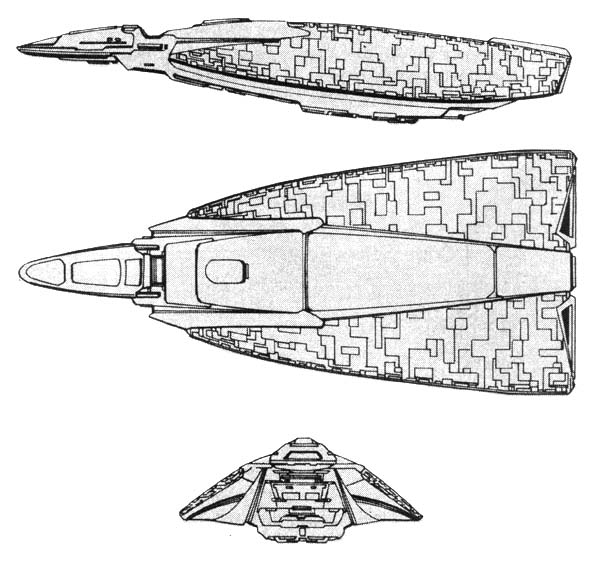«Last Updated on December 20, 2023 »
From Klingon Ship Recognition Manual, 2nd Edition, FASA, design by Forest G. Brown, graphics by Dana Knutson
NOTES:
Known Sphere Of Operation: Orion Space and the Triangle
Data Reliability: A for all models
Major Data Source: K-30A and K-30E in Star Fleet possession
The K-30 was introduced into service to replace the obsolete K-12 monitor, which was unable to operate alone, due to the lack of sufficient maneuvering capability and weaponry. The Empire was expanding at a very rapid pace and needed modern, cost-efficient ships that could operate alone. On Stardate 1/9001, the first of the K-30s were commissioned into service from the Taamar shipyards.
Not long after the commissioning ceremonies, an incident occurred that was an omen for the K-30’s future. A special carrier had been built to move the K-30s to their duty stations. While the first five monitors were being loaded onto one of these carriers, a collision occurred between two of them. Within one year, five of the 20 K-30s produced at Taamar had been destroyed, only one by hostile action. The class was building a reputation for being accident-prone. To add to the reputation, the K-30B and K-30C repeated failed tests of their new sub-light engines and were never put into production. The K-30D prototype, with the new sub-light engine and a new shield generator, suffered several mishaps, one of which damaged the ship so badly that a replacement had to be built. During the final stages of construction, the engine contractor had come up with an improved version of the original design and supplied it instead. The new prototype with the replacement engine, now the K-30E, was successfully tested, but, on Stardate 1/9804, the first five production models were destroyed in a mysterious explosion during loading operations. A prevalent Klingon nickname for the class refers to this series of events; of times called Knel (“spell’), the ships of this class are not liked by most Klingon captains and crews.
The production of the K-30 was halted on Stardate 2/0110 in favor of a newer design. As the K-30s were replaced, they were sold or traded. Of the 244 K-30s built at Taamar, 132 were destroyed, 11 have been captured by Star Fleet, 6 are listed as missing, 51 have been scrapped, 9 have been traded to the Orions and 8 to private interests in the Triangle, and 22 have been sold to private interests in the Triangle and 5 to the Orions.
| Construction Data: | ||
| Model – | a | e |
| Ship Class – | IV | IV |
| Date Entering Service – | 2247 | 2256 |
| Number Constructed – | 172 | 72 |
| Hull Data: | ||
| Superstructure Points – | 8 | 10 |
| Damage Chart – | C | C |
| Size: | ||
| Length – | 106 m | 106 m |
| Width – | 46 m | 46 m |
| Height – | 20 m | 20 m |
| Weight – | 27,718 mt | 35,218 mt |
| Cargo: | ||
| Total SCU – | 20 SCU | 20 SCU |
| Cargo Capacity – | 1,000 mt | 1,000 mt |
| Landing Capacity – | Yes | Yes |
| Equipment Date: | ||
| Control Computer Type – | ZD-3 | ZD-4 |
| Transporters: | ||
| Standard 6-person – | 1 | 1 |
| Other Data: | ||
| Crew – | 30 | 30 |
| Passengers – | 10 | 10 |
| Shuttlecraft – | 1 | 1 |
| Engines And Power Data: | ||
| Total Power Units Available – | 20 | 26 |
| Movement Point Ratio – | 2/1 | 2/1 |
| Warp Engine Type – | KSLA | KSLB |
| Number – | 2 | 2 |
| Power Units Available – | 9 ea. | 12 ea. |
| Impulse Engine Type – | KIC-1 | KIC-1 |
| Power Units Available – | 2 | 2 |
| Weapons And Firing Data: | ||
| Beam Weapon Type – | KD-2 | KD-3 |
| Number – | 7 | 6 |
| Firing Arcs – | 2 f/p, 2 f, 2 f/s, 1 a | 2 f/p, 2 f, 2 f/s |
| Firing Chart – | G | I |
| Maximum Power – | 4 | 5 |
| Damage Modifiers: | ||
| +3 | (-) | (-) |
| +2 | (-) | (-) |
| +1 | (1-10) | (1-12) |
| Beam Weapon Type – | – | KD-2 |
| Number – | – | 1 |
| Firing Arcs – | – | 1 a |
| Firing Chart – | – | G |
| Maximum Power – | – | 4 |
| Damage Modifiers: | ||
| +3 | – | (-) |
| +2 | – | (-) |
| +1 | – | (1-10) |
| Shield Data: | ||
| Deflector Shield Type – | KSC | KSJ |
| Shield Point Ratio – | 1/1 | 2/3 |
| Maximum Shield Power – | 11 | 14 |
| Combat Efficiency: | ||
| D – | 41.9 | 62.3 |
| WDF – | 9.8 | 17.6 |

